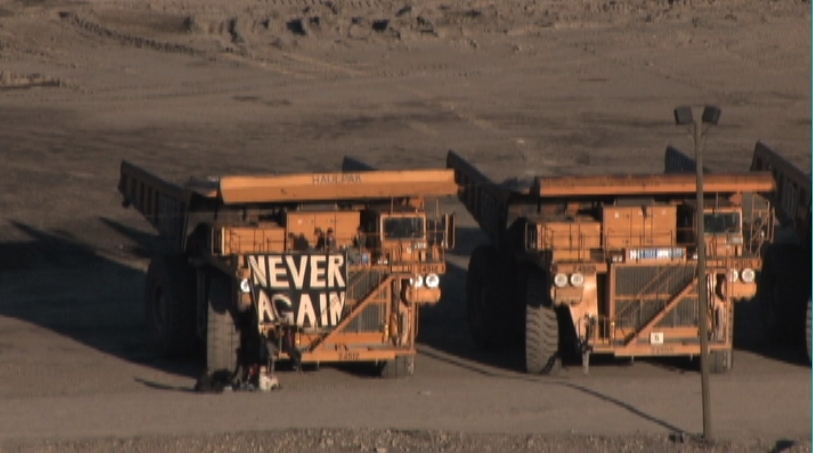In three separate direct actions in the West Virginia coalfields yesterday, nonviolent protestors launched the new phase of Operation Appalachian Spring, a growing national campaign to stop mountaintop removal mining and raise awareness of the catastrophic potential of government regulated blasting near a coal sludge impoundment.
“The toxic lake at Brushy Fork dam sits atop a honeycomb of abandoned underground mines,” said Chuck Nelson, from Raleigh County, W.Va. “Massey wants to blast within 100 feet of that dam. The company’s own filings with the state Department of Environmental Protection project a minimum death toll of 998 should the seven-billion-gallon dam break. EPA should override the DEP and revoke this blasting permit for the safety of the community.” Nelson did not participate in the civil disobedience actions.
The nearby Shumate Dam also sits a few football fields atop the Marsh Fork elementary school.
In a telling if not bizarre twist of violations and governmental priorities, Mountain Justice activists who floated a “West Virginia Says No More Toxic Sludge” banner atop the toxic multi-billion gallon Brushy Fork slurry impoundment were arrested for “littering.”
Still unable to make bail, nine of the 17 arrested protestors are being held on trespassing charges at the Southern Regional Jail in Beckley, West Virginia. In an extraordinary move to crack down on the protestors, nine violators were given a cash bail of $2000 a piece, which, according to the organizers, prohibits a bail bondsman deposit and requires full payment.
Donations for the activists’ emergency bail fund can be made at a paypal link at: www.mountainjustice.org. Facing a daily assault of over 3 million pounds of ammonium nitrate/fuel oil explosives detonated at mountaintop removal sites in Appalachia, Coal River Valley residents joined with Mountain Justice and Climate Ground Zero activists at the entrance of Massey Energy’s Marfork mining complex in Pettus, West Virginia on Saturday, May 23rd. According to the Sludge Watch Collection, seven people approached the entrance to the dam facility and the Whitesville detachment of the West Virginia State Police asked them to leave. When the seven refused, the state police arrested them.
The police refused to arrest 94-year-old former Congressman Ken Hechler, D-W.Va, who first held congressional hearings on the egregious impact of mountaintop removal in 1971. (A follow-up interview with Hechler, who led a national campaign for the abolition of strip-mining in the 1960s and 1970s, will be released later this week.)
Thirty-eight years after Hechler’s first hearings on mountaintop removal, scores of Appalachian communities have been flooded, depopulated, subjected to a boom-bust single economy of outside coal companies, and contaminated by toxic strip-mining operations; over 500 American mountains have been blown to bits, an estimated 1,300 miles of streams have been jammed with waste, and over a million acres of deciduous hardwoods forests in America’s oldest and most diverse mountain range have been wiped out.
Picketers placed 1,000 pairs of shoes to the site to represent the number of people killed if the Brushy Fork Slurry Impoundment were to burst. According to the protestors, Massey Energy’s own filings with the W.Va. Department of Environmental Protection noted the 998 potential deaths as the minimum number in the case of a catastrophic breach of the earthen dam.
A Massey subsidiary in eastern Kentucky was responsible for the largest coal slurry spill in the eastern US–until last December’s TVA coal ash pond disaster–leaking over 300 million gallons of toxic sludge into the area’s waterways and aquifers in 2000. That disaster “impacted more than 100 miles of stream beds and associated flood plains downstream,” and also covered backyards and farmland in coal slurry, according to a 2001 EPA’s task force report.
“I fear for my friends and all the people living below this coal sludge dam,” said Gary Anderson, who lives on the mountain near the site. “Blasting beside the dam, over underground mines, could decimate the valley for miles. The ‘experts’ said that the Buffalo Creek sludge dam was safe, but it failed. They said that the TVA sludge dam was safe, but it failed. Massey is setting up an even greater catastrophe here.”
In a related action, six Mountain Justice activists locked themselves to mountaintop removal equipment on the nearby Kayford mine site owned by Patriot Mining Company with a banner: “Never again!” The protestors were cited for trespassing and released.
Here’s a clip from the protests:



